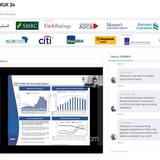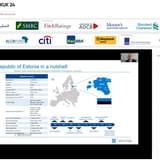Greece is making tentative steps to return to the international bond markets after three years of arduous debt restructuring negotiations with its creditors. Several outlets have reported that a Greek sovereign issuance could be imminent, following a series of meetings between Greek officials and investors.
According to a Reuters report, Greek finance minister Euclid Tsakalotos met with investors in London last month and one of the participant funds, BlueBay Asset Management, said the volume of calls they are receiving from bankers about a potential deal suggest it's very close, with some sources indicating the country’s debt management office will sell a five-year bond as soon as next week.
Greece’s current 10-year bonds rallied on the news, hitting an all-time low of 5.1% on Monday. Last week an €813mn auction of Greek 13-week treasury bills was priced at 2.33% and attracted strong international demand, according to sources quoted in the report.
Since the 2010 eurozone debt crisis, Greece tapped the markets only twice, in 2014, issuing €4.5bn of bonds at three- and five-year maturities, but a lull of stability in the global economy, a quiet period in the markets ahead of the summer hiatus and the recent debt payment to the amount of €6.8bn it made to the IMF and the ECB appear to have generated a favourable environment for the return.
Athens could achieve a number of goals if the issuance is deemed a success, say analysts and investors who spoke to Bonds and Loans. For now, the country is not in dire need for cash, as the IMF loan tranches have helped to plug budget holes and talks with creditors are largely going in Greece’s favour, so any issuance now would be more of a “brand boost”.
“Being seen to be able to come back to the market would be a sign of success for the government, so the reputational element is very important here. It is a “starting point of putting Greece back on its own two feet” – a phrase that Greek officials have used recently,” commented Stuart Culverhouse, Executive Director and Head of Research at Exotix, an investment bank.
Richard Segal, EM credit analyst for Manulife, agreed that one of the goals is to re-establish themselves on the market. He also pointed to the current outstanding bonds, which have reached a recent cyclical low: the 10-year debt is roughly at 6%, having come down from 8.5% last October.
“In 2014 Greece found quite a good window to issue, luckily for them because it then closed for a number of economic & political reasons. Now the outlook is quite favourable, because the government has established a lot more policy credibility. Also, the big EU economies are looking much better, with higher-risk countries like Spain now in much better shape. So the backdrop in the peripheral countries is much better,” Segal concluded.
EM or DM?
Traditionally, whenever there is an agreement with the IMF or other multilateral lenders, it is always viewed as a natural step for the borrower should go to the private markets, as opposed to just relying on international aid. In Greece’s case, however, instead of tapping the market AFTER receiving financial aid, the country is doing it ahead.
Segal speculates that perhaps it is down to the government not feeling the need for the IMF cash, now that it is in position to attract foreign capital. Another reason is that there is lot more oversight of Greece than your typical EM, particularly since the IMF was criticised for the way it handled the Greek crisis.
But Athens should be wary of rushing too fast to the debt markets, particularly as the country’s recent history does not bode well for attracting new investor pools.
“Back in 2014 things were looking up for them, they looked to be finally emerging from the previous bail-out programmes. Of course, then the politics took a turn for the worse and what followed is effectively three lost years. The situation now still requires significant debt relief, so there is still uncertainty, which, particularly with past problems in mind, will weigh on investor sentiment. So it is essential that they stay committed to reform,” Culverhouse noted.
These doubts are likely to be reflected in the pricing of the new notes. The April 2019 bond, issued at a 4.95% yield in 2014, was trading around a 3.55% yield on Monday, according to the FT, with some investors expecting the new issuance to likely price at a yield of above 4.5% - a level that is significantly more attractive than the near-zero eurozone yields and on par with some emerging market economies.
Some see this as an opportunity for Greece to lock in relatively low yields (compared to the 8.5% seen in October) and expand its fixed income investor base, perhaps even pushing into the EM universe.
“Greece falls in between the two investor pools – for DM investors it is a little bit “hairy”, too small in the big scheme of things and, probably, too illiquid and risky for them. For EM investors – it DOES have an EM feel to it, but, obviously, it is not in EM benchmarks,” Culverhouse explained.
But while there isn’t really an EM market for it, he added, it enables some of these investors and asset managers to look at Greece as an off-benchmark opportunity with relatively high-yield, well-performing bonds.
“Of course, that is conditioned on yields remaining high: as they come down, there may be less upside, so it becomes a bit more capped and as it is not in the benchmark, you don’t have a ready audience of index people prepared to buy it. Unfortunately for Greece, its debt falls between the two stools. Still, it might appeal to some people while we are in this calm period, particularly with the support of IMF and international institutions.”
Segal said he tends to differentiate EMs and DMs on the basis of their economies, not markets – and from that perspective still considers Greece a developed economy, which due to high debt levels and a history of default carries EM-type yields, which are unlikely to persist for more than 5 years.
“I think that it will come down to preferences individual portfolio managers, as most PMs investing in emerging market have capacity to stray from their typical market on some occasions. Whether they choose to go for Greece for the yields, or US treasuries for safety and liquidity, or AA-credit like Qatar or the yield relative to ratings – it’s up to them. Most EM portfolio managers that I know would probably stay away from Greece, but others, who invest in Bulgaria or, say, Macedonia, would be tempted to invest into Greek debt too.”
The analyst does add, however, that if the upcoming debt sale sets a strong benchmark and begins to generate momentum on the fixed income side, it could open a pipeline of corporate issuances – for example, in sectors like utilities, telecoms or even Coca Cola bottling. It would also help to improve the liquidity in the banking sector, which in turn would take some pressure off the Greek banks and allow local lower-tier corporates to access bank financing.
But many of these developments are contingent on the government upholding its side of the bargain. This includes, first of all, completing the debt restructuring process (which in some ways hangs on the outcome of the German elections), but also continued structural reforms, industry liberalisation, improving business climate and attracting more FDI etc.
In classic Greek tragedy, the protagonist often brings about his own downfall. Having followed that path multiple times in the past, the Greeks ought to now learn from those mistakes and find a better way forward.









